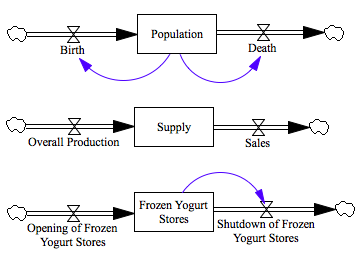
Stocks and flows are the basic building blocks of system dynamics models. Jay Forrester originally referred to them as "levels" (for stocks) and "rates" (for flows). A stock variable is measured at one specific time, and represents a quantity existing at that point in time (say, December 31, 2004), which may have accumulated in the past. A flow variable is measured over an interval of time. Therefore a flow would be measured per unit of time (say a year).
A stock is accumulated over time by inflows and/or depleted by outflows. Stocks can only be changed via flows. Mathematically a stock can be seen as an accumulation or integration of flows over time – with outflows subtracting from the stock. Stocks typically have a certain value at each moment of time – e.g. the number of population at a certain moment.
A flow changes a stock over time. Usually we can clearly distinguish inflows (adding to the stock) and outflows (subtracting from the stock). Flows typically are measured over a certain interval of time – e.g., the number of births over a day or month.
Examples[edit | edit source]
| "Stock" | Possible units of stock | "Inflow(s)" | "Outflow(s)" | Possible units of flow |
|---|---|---|---|---|
| water in bathtub | liters | water pouring in | water draining out | liters per second |
| CO2 in atmosphere | tons | tons emitted | tons sequestered | tons per day |
| bank balance | euros | deposits interest |
withdrawals | euros per month |
| inventory of lumber | board feet | incoming lumber | outgoing lumber | board feet per week |
| guests in a hotel | persons | guests arriving | guests leaving | persons per day |
| population | persons | births immigration |
deaths emigration |
persons per year |
| waste in disposal site | tons | dumping waste | decay of waste | tons per week |
| fuel tank | gallons | refueling | fuel consumption | gallons per month |
| housing stock | dollars | housing investment | housing depreciation | dollars per year |
Stocks and flows in accounting[edit | edit source]
Thus, a stock refers to the value of an asset at a balance date (or point in time), while a flow refers to the total value of transactions (sales or purchases, incomes or expenditures) during an accounting period. If the flow value of an economic activity is divided by the average stock value during an accounting period, we obtain a measure of the number of turnovers (or rotations) of a stock in that accounting period. Some accounting entries are normally always represented as a flow (e.g. profit or income), while others may be represented both as a stock or as a flow (e.g. capital).
A person or country might have stocks of money, financial assets, liabilities, wealth, real means of production, capital, inventories, and human capital (or labor power). Flow magnitudes include income, spending, saving, debt repayment, fixed investment, inventory investment, and labor utilization.These differ in their units of measurement. Capital is a stock concept which yields a periodic income which is a flow concept.
